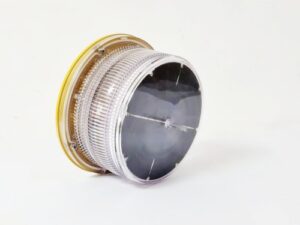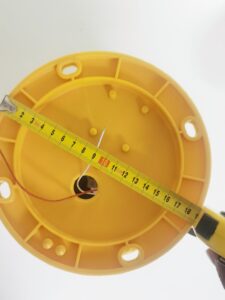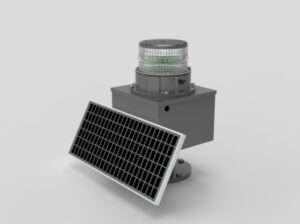Selecting the correct obstruction light for chimneys, flare stacks, and similar solid structures is crucial for ensuring aerial and nearby safety, especially during nighttime or low-visibility conditions. These lights play a pivotal role in notifying aircraft and other potential obstacles about the presence of such structures.

CHAPTER 5. RED OBSTRUCTION LIGHT SYSTEM
5.6 Chimneys, Flare Stacks, and Similar Solid Structures (except Hyperbolic Cooling Towers).
5.6.1 Number of Light Units.
The number of units recommended depends on the diameter of the structure at the top. The number of lights recommended below is the minimum (see Figure A- 10).
1. Structures 20 feet (6.10 m) or less in diameter. Three light units per level.
2. Structures exceeding 20 feet (6.10 m) but not more than 100 feet (31 m) in diameter. Four light units per level.
5.6.2 Top-Mounted Obstruction Lights.
1. Structures 150 feet (45.72 m) AGL or less. L-810 lights should be installed horizontally at regular intervals at or near the top.
2. Structures exceeding 150 feet (45.72 m) AGL. At least three L-864 lights should be installed.
3. Chimneys, Cooling Towers, and Flare Stacks. Lights may be displayed as low as 20 feet (6.10 m) below the top (, Figure A-7) to avoid the obscuring effect of deposits and heat generally emitted by this type of structure. It is important that these lights are readily accessible for cleaning and lamp replacement. It is understood that with flare stacks, as well as any other structures associated with the petrol-chemical industry, normal lighting requirements may not be necessary. This could be due to the location of the flare stack/structure within a large, well-lighted, petrol-chemical plant, or the fact that the flare, or working lights surrounding the flare stack/structure, is as conspicuous as obstruction lights.
5.6.3 Mounting Intermediate Levels.
The number of light levels is determined by the height of the structure including all appurtenances. Structures between 150 feet and 350 feet (45.72 m and 106.68 m) AGL should have a second level of steady-burning red light units installed approximately at the midpoint of the structure and in a vertical line with the top level of lights. Structures exceeding 350 feet (106.68 m) AGL should have a second level of flashing light units. For cooling towers 600 feet (182.88 m) AGL or less, intermediate light levels are not necessary.
1. Steady-burning (L-810) lights. The recommended number of light levels is shown in Figure A-6. At least three lights should be installed on each level.
2. Flashing (L-864) lights. The recommended number of light levels is shown in Figure A-6.
a. These structures do not need intermediate levels of flashing lights. Structures 350 feet (106.68 m) AGL or less.
b. At least three flashing (L-864) lights should be installed on each level in a manner allowing an unobstructed view of at least one light. Structures exceeding 350 feet (106.68 m) AGL.
CHAPTER 6. MEDIUM-INTENSITY FLASHING WHITE OBSTRUCTION LIGHT SYSTEMS
6.5 Chimneys, Flare Stacks, and Similar Solid Structures.
The recommended number of top-level light units depends on the diameter of the structure at the highest point of a structure. The lights should be installed at the highest point, however, top level chimney lights may be installed as low as 20 feet (6.10 m) below the top to minimize deposit build-up due to emissions (see Figure A-10). The number of lights per level below is the minimum recommended.

1. Structures 20 feet (6.10 m) or less in diameter. Three light units per level
2. Structures exceeding 20 feet (6.10 m) but not more than 100 feet (31 m) in diameter. Four light units per level.
CHAPTER 7. HIGH-INTENSITY FLASHING WHITE OBSTRUCTION LIGHT SYSTEMS
7.8 Chimneys, Flare Stacks, and Similar Solid Structures.
The number of light levels depends on the height of the structure, excluding appurtenances. Three or more lights should be installed on each level to ensure an unobstructed view by the pilot. Normally, the top level lights are on the highest point of a structure, however, top level chimney lights may be installed as low as 20 feet (6.10 m) below the top to minimize deposit buildup due to emissions.
Conclusion:
To choose the right obstruction light for a chimney or similar structure, one must consider factors like the diameter and height of the structure. For structures with diameters up to 20 feet, three light units per level are recommended, whereas those between 20 to 100 feet require four units. Furthermore, the height determines whether steady-burning or flashing lights are needed, and how many intermediate levels of lights are appropriate. For chimneys, flare stacks, and similar entities, it’s also essential to account for potential obstructions like deposits or emissions when positioning the lights. Therefore, understanding these guidelines ensures the right light is chosen, promoting safety and visibility.
Models for chimneys at WelandSignal







